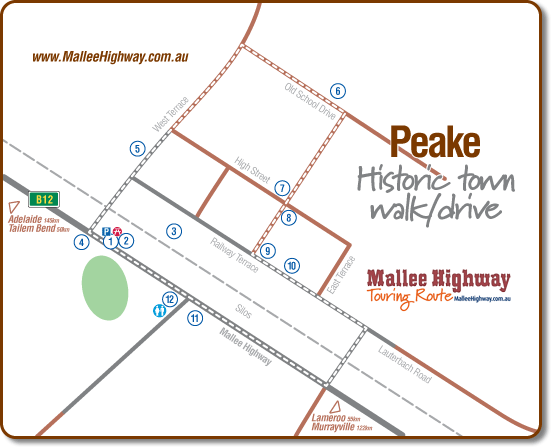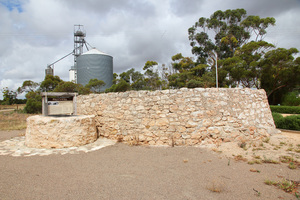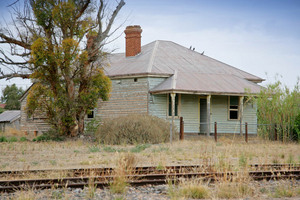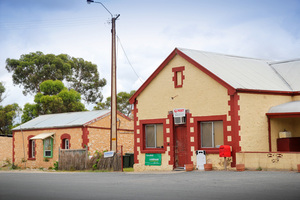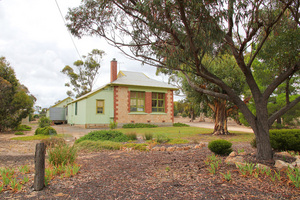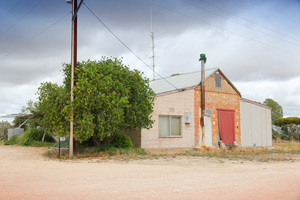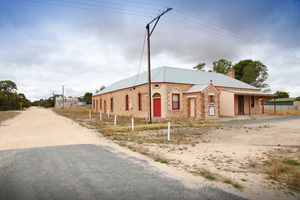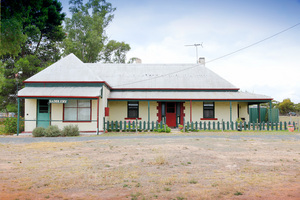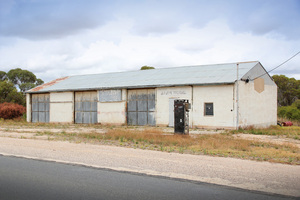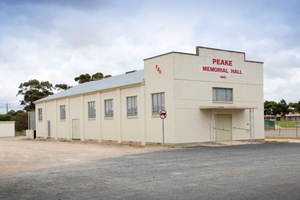
Peake the historic settlement on the Mallee Highway
1. Polly's Well
The well was sunk in 1877 to a depth of 16.5 metres. It is timbered to 8.4 metres and the well had a good supply of water. At the turn of the century water was being drawn from the well with the aid of a horse and buckets. The well, along with many others in the district, was sunk during the time when John Whyte, the first pioneer and pastorialist to stock this country, leased the land in this area. The well has since been filled in and the huge trough long since disappeared. It is reputed that the station homestead (where Peake Oval now is) and the trough were taken down and the stone used in the buildings was sold further up the Pinnaroo line where stone was rare.
Many interpretations on the origin of the name 'Polly's Well' have developed over the years. One theory is that the horse, which drew the buckets of water from the well, was called Polly. Another theory is that a horse or cow called Polly met its fate by falling in the well! It is also suggested that the well was named after the wife of an early pioneer. Was it a horse, a lady or a dead cow?
The first Baptist church service was held on 15 December 1907 at the Lee family house (where the Tavern now is), across the road from Polly's Well. the second service was held alongside the Well.
2. Peake Lone Pine and War Memorial
On August 6th, 1915, the 1st Australian Infantry Division launched a major offensive at Plateau 400 at Gallipoli, Turkey. The ridges had once been covered with Aleppo Pines, however, they had been cut down to line and over trenches with only a solitary pie remaining. hence it became known as Lone Pine Ridge.
In the 3 days of fighting the A.N.Z.A.C.s lost 2,000 men and the Turks an estimated 7,000.
Several pine cones were sent by Lance Corporal B.J. Smith of the 3rd Battalion back to Australia. Thirteen years later two seedlings were grown, one of which was planted at the Australian War Memorial in Canberra.
These Pines (at Peake) were planted here on the 25th April 2009 having been propagated from the tree at the Australian War Memorial.
3. Peake Station Master's House
The Station Master's House was built in 1912.
The last Peake Station master, Jozeff (Joe) Suchon died along in this house on 8 January 1990. He was 78 years old.
4. Peake Store (now Tavern)
Peake had a new stone general store, in about 1937, built by Murray Shepley on the south side of the Mallee Highway.
Scott Harvey remembered Reg How coming down the Karoonda Road into Peake in a horse and cart, heading to the railway station with a cart of cream. Halfway down the hill the horse took fright and bolted, as the cart careered over the railway line, the can of cream was lost. The horse was forced to veer wildly at the last second to avoid hitting the Peake store, the cart swung, skidded sideways and the wheel hub tore out each of the three posts supporting the verandah, collapsing the entire verandah frontage.
In the 1980s the store was converted to a tavern.
5. Peake Post Office
Mr William Riches had a store built by the Paine brothers in 1912, which also housed the Post Office run by Mrs. Lee.
On the front porch of the Post Office, Mr Stratford, the visiting dentist, used the extract teeth for sixpence and later used to drill and fill teeth using foot pedalled apparatus.
One day, Jessie Payne went to the Post Office, with her brother Bronte, on the back of Mick the horse. Jessie tied Mick to the telephone box door. Suddenly frightened, the horse took off the door and all. She finally caught up with Mick in the scrub, with the door caught between two mallee trees.
6. Peake Peake School
The new school was opened in September, 1929.
The children now had a dedicated school building which became the general design for schools in South Australia's Mallee area.
There's a goanna in the toilet! There's a snake down the toilet pit! - Were both exclamations often heard in these early school days.
School picnics were a highlight of the year. Patricia Johnson, who was a teacher at the school in the 40s, recalls the picnic at Meningie where someone lost their false teeth in the lake! a methodical search did not locate them.
7. Peake Old Hall / School
This building was the local hall from 1913 until 1961, when the new hall was opened.
School was also held there until 1929, when the Peake School was opened. It is believed that the stone part of the building, which remains today, was built first and later extended with a wood and iron structure.
The story is told of a dispute between committee members of the type of materials to be used for the extension. Some wanted it to be stone and others preferred wood and iron (which would be much quicker to construct). Eventually the foundation layers of rock were laid for a stone building but the opponents, not wanting to be out done, ripped them up one night and consequently wood and iron was used.
8. Peake Butcher Shop
Two rooms of this building were built by the Lewis Brothers (in the early 1900s) and leased as a butcher shop to Mr. Seddon for a few years, until drought forced its closure.
9. Peake Bakehouse / Baptist Church
Moore and Trezise constructed this substantial stone building for a bakehouse. It opened as refreshment rooms, to serve railway passengers in August 1908. Contrary to popular belief it was never built to be a hotel.
In 1922 it was sold to the Home Mission Department, for use as the new Baptist Church. Water was carried three miles for a baptismal service at Peake in 1933/34 and after the service the water was siphoned out through a side window in the Church.
For baptisms during the period 1968 to 1970, water was fed into the baptistry by a garden hose running from the adjoining manse and after the service, allowed to drain into the rock strata under the Church.
10. Peake Saddlery
Harold Porter opened a saddlery business here in Peake, in 1912, with agencies for wheat, machinery, superphosphates, newspaper and insurance.
In 1918 he opened a grocery business on the same premises, but closed it in 1919.
The saddlery business continued until the house and shop were sold to the South Australian Railways.
11. Peake Garage
This building was used as a garage from 1956 until 1974. First owner, Eric Hosgood, cut the top of his finger off whilst repairing a movie picture generator engine, for pictures being shown in the local hall, in about 1959. He went outside, feeling a little 'woozy' and the generator was taken back to the hall, as 'the show must go on' for the patrons. The next morning, Eric was found outside the garage, just coming around after having spend all night there. He was taken to Tailem Bend Hospital to have his finger 'repaired'.
The garage was also the local 'waterhole' and many locals gathered there, not necessarily for vehicle repairs. Steve Cowling and Ernie Greenslade had many an argument about politics at the garage.
Some acquired beer etc. there to take home for 'medicinal' purposes. Second owner, John Wheaton, introduced kegs of wine and made them available for flagon refills, for those who called in for 'repairs'. Cold wintry days usually found some local men gathered around 'Wheat's' big oil heather, with plonk in hand, discussed anything of interest to them.
12. Peake Memorial Hall
In the mid thirties the residents of Peake realised the old Hall built in 1910, was inadequate for the growing needs of the district. They investigated the first moves to build a new memorial hall.
Most funds were raised by cropping project, which took several years as droughts prevented good yields and returns.
After these efforts and other functions accumulated a reasonable amount of money, the contract to build the hall was let to Messrs. Seedlander and White of Coonalpyn, in November 1960.
Tee's Windmill House
A local story. In 1941 the Tee family moved into their new home at Peake, which had a well in one of the rooms. Apparently a pig had fallen down the well, which was not use. They could not get it out and so it filled with sand.
Mr. Tee used to cart the water for the stock, but soon became tired of this, so he asked Jim Cronin from Coonalpyn, a boring contract, to drill a hole to water and case the well.
When all was completed, Mr. Tee put a long mallee stick on the bore rod over the windlass and everyone in the family took it in turns to pump the daily water for the animals.
This was great fun for awhile, but the three girls soon tried to find something more important to do, so their Dad brought a windmill, cut a hole in the roof and put it up through the roof, causing many comments and laughs.
Mallee Highway Touring Route
Source: Peake; the Historic Settlement brochure
Coorong District Council and Limestone Coast Tourism
Tell your friends you found this at murrayriver.com.au!
Copyright Discover Murray 2025. This site or any portion of this site must not be reproduced, duplicated, copied, sold, resold, or otherwise exploited for any commercial purpose that is not expressly permitted by DISCOVER MURRAY.






 Lee Kernaghan Boys From The Bush The Concert
Lee Kernaghan Boys From The Bush The Concert Little By Little
Little By Little Amy Shark The Solo Acoustic "Songs & Stories" Tour
Amy Shark The Solo Acoustic "Songs & Stories" Tour The Australian Beach Boys Show
The Australian Beach Boys Show Kevin Bloody Wilson Aussie Icon Tour with special guest Jenny Talia
Kevin Bloody Wilson Aussie Icon Tour with special guest Jenny Talia
